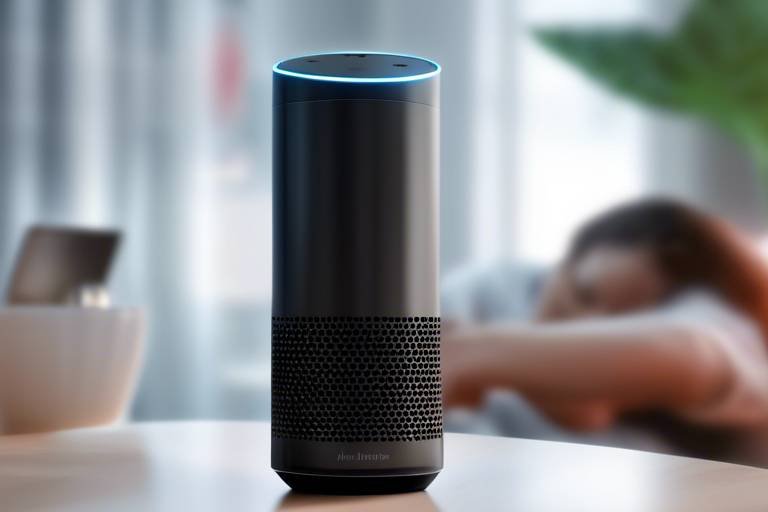AI in Retail: Redefining the Consumer Experience
In recent years, the retail industry has undergone a dramatic transformation, largely driven by the rise of artificial intelligence (AI). This technology is not just a buzzword; it’s reshaping how consumers interact with brands and how retailers operate. Imagine walking into a store where the shelves seem to know exactly what you want, or browsing online and finding products that feel like they were handpicked just for you. That’s the power of AI in retail, creating a shopping experience that feels personal, efficient, and incredibly engaging.
At its core, AI in retail is about enhancing the consumer experience. It’s about understanding customer preferences and behaviors on a granular level. Retailers are now using AI to analyze vast amounts of data—from purchase histories to social media interactions—allowing them to tailor their offerings in ways that were previously unimaginable. This level of personalization not only boosts customer satisfaction but also fosters loyalty, as shoppers feel more connected to brands that understand their needs.
Moreover, the integration of AI goes beyond just personalization. It is streamlining operations and improving efficiency across the board. For instance, retailers can now leverage AI-driven analytics to optimize inventory management, ensuring that products are always in stock and available for customers. This not only reduces waste but also enhances the overall shopping experience, making it seamless and enjoyable.
As we delve deeper into the various applications of AI in retail, it's essential to recognize its transformative potential. From personalized shopping experiences to enhanced customer service, AI is not just a trend; it's a game-changer that is redefining the retail landscape. Are you ready to explore how AI is revolutionizing your shopping experience?
AI technologies enable retailers to deliver tailored recommendations, ensuring that customers receive personalized product suggestions based on their preferences and browsing history. This means that when you visit an e-commerce site, the platform is analyzing your past behaviors and suggesting items that align with your tastes. Think of it like having a personal shopper who knows exactly what you like!
With AI-driven analytics, retailers can predict demand more accurately, streamline inventory management, and reduce waste, ultimately leading to cost savings and improved customer satisfaction. Imagine a store that never runs out of your favorite product because it can anticipate demand before it happens. This is the reality that AI is creating, where data-driven decisions lead to a smoother shopping experience.
AI algorithms analyze historical sales data and market trends to forecast demand, allowing retailers to make informed decisions about stock levels and product availability. This predictive capability means that retailers can stay ahead of the curve, ensuring that they have the right products at the right time.
Utilizing AI-powered systems, retailers can monitor stock levels in real-time, ensuring that popular items are always available for customers and minimizing lost sales opportunities. Imagine never having to hear, “Sorry, we’re out of stock” again!
AI can automate the replenishment process, ensuring that products are restocked efficiently based on predictive analytics, reducing the risk of overstocking or stockouts. This means that retailers can focus more on enhancing customer experiences rather than worrying about inventory issues.
AI enhances supply chain operations by optimizing logistics, improving delivery times, and reducing costs, thereby creating a more efficient retail ecosystem. It’s like having a well-oiled machine that runs smoothly, ensuring that everything from manufacturing to delivery is streamlined.
AI chatbots and virtual assistants provide 24/7 customer support, addressing inquiries and resolving issues quickly, improving overall customer satisfaction and engagement. Think about it—how convenient is it to get answers to your questions at any hour of the day without having to wait on hold?
Retailers are increasingly adopting AI-driven chatbots to handle customer inquiries, offering instant responses and personalized assistance to enhance the shopping experience. These chatbots are like your friendly neighborhood helpers, ready to assist you anytime you need.
AI tools analyze customer reviews and feedback to gauge sentiment, helping retailers understand consumer perceptions and improve their products and services accordingly. This is crucial for brands looking to adapt and evolve based on what their customers truly think.
AI enables retailers to analyze consumer behavior and preferences, leading to more effective marketing campaigns and better-targeted advertisements, ultimately driving sales. By understanding what makes customers tick, retailers can create marketing strategies that resonate and engage.
By leveraging predictive analytics, retailers can identify potential customer segments for targeted marketing efforts, increasing the likelihood of conversions and customer loyalty. It’s like casting a net in the right waters, ensuring that your marketing efforts don’t go to waste.
AI can optimize pricing strategies in real-time based on market demand, competitor pricing, and customer behavior, ensuring retailers remain competitive while maximizing profits. This means that prices can fluctuate in a way that benefits both the retailer and the consumer, creating a win-win situation.
- How is AI used in retail? AI is used in retail to enhance customer experiences through personalized recommendations, optimize inventory management, and improve customer service with chatbots.
- What are the benefits of AI in retail? The benefits include improved customer satisfaction, increased efficiency in operations, better inventory management, and more effective marketing strategies.
- Will AI replace human jobs in retail? While AI can automate certain tasks, it also creates new opportunities for human roles that focus on strategy, creativity, and customer relations.

Personalized Shopping Experiences
In today's fast-paced retail environment, personalization has become a buzzword that resonates with consumers. Imagine walking into a store where every product seems to speak directly to your tastes and preferences—that's the magic of AI in retail. With the help of advanced algorithms, retailers can now deliver tailored recommendations that ensure customers are not just browsing, but discovering products that genuinely interest them.
How does this work, you ask? Well, AI technologies analyze a customer's browsing history, purchase patterns, and even social media interactions to curate a shopping experience that feels uniquely yours. This means that when you log into your favorite online store, the homepage might greet you with items that align perfectly with your past purchases and current trends. It's like having a personal shopper available 24/7, guiding you through a sea of options to find exactly what you need.
Moreover, this personalized approach is not just limited to online shopping. In brick-and-mortar stores, retailers are using AI to enhance the in-store experience as well. For instance, imagine walking into a clothing store that recognizes you from your previous visits and suggests outfits based on your style preferences. This level of personalization creates an emotional connection between the customer and the brand, fostering loyalty and encouraging repeat visits.
But it doesn't stop there! AI can also analyze customer feedback and behavior in real-time, allowing retailers to adjust their offerings on the fly. For example, if a particular product is gaining traction among customers, AI can help highlight it in marketing campaigns or even suggest it to other shoppers who might be interested. This dynamic interaction not only keeps the shopping experience fresh and exciting but also drives sales and enhances customer satisfaction.
To illustrate the impact of personalized shopping experiences, consider the following table that highlights key benefits:
| Benefit | Description |
|---|---|
| Increased Customer Engagement | Personalized recommendations keep customers interested and engaged with the brand. |
| Higher Conversion Rates | Tailored suggestions lead to more purchases as customers find what they love easily. |
| Improved Customer Loyalty | When customers feel understood, they are more likely to return for future purchases. |
In conclusion, the integration of AI in creating personalized shopping experiences is revolutionizing the retail landscape. It’s not just about selling products anymore; it’s about creating a connection with customers that feels genuine and intuitive. As retailers continue to embrace these technologies, we can expect shopping to become an even more tailored experience that caters to our individual needs and preferences.

Inventory Management Optimization
In the fast-paced world of retail, has become a crucial factor for success. With the advent of artificial intelligence, retailers are now equipped with powerful tools that not only enhance their operational efficiency but also significantly improve customer satisfaction. Imagine walking into a store where every item you want is in stock, or receiving a package at your doorstep exactly when you expect it. This is not just a dream; it’s a reality made possible by AI.
AI-driven analytics are revolutionizing how retailers predict demand, manage stock levels, and ultimately cater to their customers' needs. By utilizing sophisticated algorithms, retailers can analyze historical sales data alongside current market trends to forecast demand accurately. This means they can stock up on popular items before they fly off the shelves, ensuring that customers are never left disappointed. For instance, during the holiday season, retailers can anticipate which products will be in high demand, allowing them to prepare adequately.
Retailers are leveraging AI algorithms to delve deep into their sales data, identifying patterns and trends that human analysts might miss. This approach allows them to make informed decisions about stock levels and product availability. For example, if a retailer notices a consistent spike in sales for a particular item during a specific month, they can adjust their inventory accordingly. Moreover, these algorithms are continuously learning and evolving, meaning they get better at forecasting with each passing season.
Another game-changer in inventory management is the implementation of real-time inventory tracking systems powered by AI. Retailers can monitor stock levels continuously, ensuring that popular items are always available for purchase. This not only minimizes lost sales opportunities but also enhances the overall shopping experience. Imagine browsing your favorite online store and finding that the item you want is readily available, thanks to efficient inventory tracking. It creates a seamless experience that keeps customers coming back for more.
Furthermore, AI can automate the replenishment process, ensuring that products are restocked efficiently based on predictive analytics. This means retailers can reduce the risk of both overstocking and stockouts, which are common pitfalls in traditional inventory management. The automation of replenishment not only saves time but also cuts costs associated with manual inventory checks. As a result, retailers can focus more on enhancing customer experiences rather than getting bogged down by logistics.
| Benefits of AI in Inventory Management | Description |
|---|---|
| Improved Accuracy | Reduces errors in stock levels and demand forecasting. |
| Cost Savings | Minimizes waste and reduces overhead costs. |
| Enhanced Customer Satisfaction | Ensures product availability and timely deliveries. |
| Increased Efficiency | Automates routine tasks, freeing up staff for more valuable work. |
In summary, the integration of AI into inventory management is not just a trend; it’s a necessary evolution in the retail sector. With personalized shopping experiences, accurate demand forecasting, real-time tracking, and automated replenishment systems, retailers can create a more efficient and satisfying shopping environment. This not only boosts their bottom line but also fosters loyalty among customers who appreciate the convenience and reliability that AI brings to their shopping experience.
- How does AI improve inventory management? AI enhances inventory management by providing accurate demand forecasting, real-time tracking, and automated replenishment, leading to better stock control and customer satisfaction.
- What are the benefits of real-time inventory tracking? Real-time inventory tracking helps retailers avoid stockouts, reduces lost sales opportunities, and ensures that popular items are always available for customers.
- Can AI reduce costs in retail? Yes, AI can significantly reduce costs by minimizing waste, optimizing stock levels, and automating routine inventory tasks.

Demand Forecasting Techniques
In the fast-paced world of retail, demand forecasting has become a cornerstone for success, enabling retailers to stay ahead of the curve. Imagine trying to catch a wave; if you can predict when and how big it will be, you're more likely to ride it smoothly rather than wipe out. Similarly, AI algorithms have the power to analyze vast amounts of historical sales data and market trends, allowing retailers to anticipate future demand with remarkable accuracy.
One of the most effective methods used in demand forecasting is the application of time series analysis. This technique involves examining sales data over specific time intervals to identify patterns and trends. For example, if a retailer notices a spike in sales of winter coats every November, they can prepare to stock up ahead of time. This proactive approach not only helps in maintaining optimal inventory levels but also enhances customer satisfaction, as popular items are readily available when consumers want them.
Another powerful tool is the use of machine learning, which allows retailers to refine their forecasting models continuously. By learning from new data, machine learning algorithms can adjust their predictions in real-time. This is akin to having a personal coach who helps you improve your skills based on your performance. As these algorithms process more data, they become increasingly adept at recognizing subtle shifts in consumer behavior, seasonal trends, and even external factors like economic conditions or social media buzz.
Moreover, retailers can leverage predictive analytics to enhance their forecasting accuracy. This involves using historical data, along with external variables such as weather patterns and local events, to predict future sales. For instance, if a major sporting event is scheduled in a city, retailers can expect an uptick in sales of related merchandise. By incorporating these variables into their forecasting models, retailers can make informed decisions about stock levels and promotional strategies.
To illustrate the impact of demand forecasting techniques, consider the following table that highlights how various methods contribute to more accurate predictions:
| Forecasting Method | Description | Benefits |
|---|---|---|
| Time Series Analysis | Analyzes historical sales data to identify patterns over time. | Improves inventory management and customer satisfaction. |
| Machine Learning | Uses algorithms to learn from data and adjust predictions. | Increases accuracy by adapting to new trends and behaviors. |
| Predictive Analytics | Incorporates external variables to forecast future sales. | Enhances decision-making regarding stock levels and promotions. |
In conclusion, by employing these advanced demand forecasting techniques, retailers can not only optimize their inventory but also enhance their overall operational efficiency. This leads to a more streamlined shopping experience for consumers, ensuring that they find what they need when they need it. As the retail landscape continues to evolve, those who harness the power of AI in demand forecasting will undoubtedly ride the wave of success.
- What is demand forecasting? Demand forecasting is the process of predicting future customer demand for products based on historical data and market trends.
- How does AI improve demand forecasting? AI enhances demand forecasting by analyzing vast amounts of data, identifying patterns, and continuously learning from new information to refine predictions.
- What are the benefits of accurate demand forecasting? Accurate demand forecasting helps retailers maintain optimal inventory levels, reduce waste, improve customer satisfaction, and ultimately drive sales.

Real-time Inventory Tracking
In today's fast-paced retail environment, has become a game changer for businesses looking to stay ahead of the competition. Imagine walking into your favorite store and finding exactly what you need, without the frustration of empty shelves. This is made possible through advanced AI-powered systems that monitor stock levels continuously, providing retailers with up-to-the-minute information about product availability.
By utilizing sophisticated algorithms and data analytics, these systems can track inventory across multiple locations, ensuring that retailers can respond swiftly to changes in demand. For instance, if a particular item is flying off the shelves, the system can immediately alert the management to restock the item before it runs out. This not only enhances the customer experience but also minimizes lost sales opportunities, which can be detrimental to a retailer's bottom line.
Moreover, real-time inventory tracking can significantly reduce the chances of overstocking or stockouts. With accurate data at their fingertips, retailers can make informed decisions about when and how much to reorder. This leads to improved cash flow management and reduces the costs associated with excess inventory. In fact, studies have shown that retailers who implement real-time tracking systems can reduce their inventory costs by up to 30%.
To illustrate the impact of real-time inventory tracking, consider the following table, which showcases the benefits and features of implementing such a system:
| Benefits | Features |
|---|---|
| Improved Customer Satisfaction | Instant stock level updates |
| Reduced Operational Costs | Automated reorder alerts |
| Enhanced Decision Making | Data-driven insights for inventory management |
| Increased Sales Opportunities | Real-time analytics on popular products |
In conclusion, implementing a real-time inventory tracking system is not just a luxury but a necessity for modern retailers. It empowers them to offer a seamless shopping experience, ensuring that customers leave satisfied and ready to return. As technology continues to evolve, those who embrace these innovations will undoubtedly thrive in the retail landscape.
- What is real-time inventory tracking? Real-time inventory tracking refers to the use of technology to monitor stock levels continuously, providing immediate updates on product availability.
- How does AI enhance inventory management? AI enhances inventory management by analyzing sales data and predicting demand, allowing retailers to make informed decisions about stock levels.
- What are the benefits of real-time inventory tracking? Benefits include improved customer satisfaction, reduced operational costs, enhanced decision-making, and increased sales opportunities.
- Can real-time inventory tracking reduce costs? Yes, it can significantly reduce costs associated with overstocking and stockouts, leading to better cash flow management.

Automated Replenishment Systems
In the fast-paced world of retail, Automated Replenishment Systems (ARS) are revolutionizing the way businesses manage their inventory. Imagine a scenario where stock levels are monitored in real-time, and products are automatically reordered just before they run out. Sounds like a dream, right? Well, thanks to AI technology, this is now a reality. These systems utilize advanced algorithms to analyze sales patterns, predict demand, and ensure that shelves are always stocked with the right products at the right time. This not only enhances operational efficiency but also significantly improves customer satisfaction.
At the heart of ARS is the ability to leverage predictive analytics. By examining historical sales data and considering external factors such as seasonality, promotions, and market trends, these systems can forecast future demand with impressive accuracy. For instance, if a retailer notices a spike in sales of winter jackets every December, the ARS will automatically adjust the inventory levels to ensure that there are enough jackets available as the holiday season approaches. This proactive approach minimizes the risk of stockouts, which can lead to lost sales and dissatisfied customers.
Furthermore, ARS can also help retailers avoid the pitfalls of overstocking. Overstocking not only ties up capital but can also lead to excess inventory that may need to be discounted or, worse, written off. By automating the replenishment process, retailers can find that sweet spot between having enough stock to meet customer demand while avoiding the costs associated with surplus inventory. This balance is crucial for maintaining a healthy bottom line.
To illustrate the effectiveness of Automated Replenishment Systems, consider the following table that summarizes the key benefits:
| Benefit | Description |
|---|---|
| Improved Stock Availability | Ensures popular items are always in stock, reducing lost sales opportunities. |
| Cost Efficiency | Reduces the costs associated with overstocking and stockouts. |
| Time Savings | Automates the ordering process, freeing up staff to focus on other tasks. |
| Data-Driven Decisions | Utilizes AI analytics to make informed inventory management decisions. |
In conclusion, the integration of Automated Replenishment Systems in retail not only streamlines inventory management but also enhances the overall shopping experience for consumers. By ensuring that products are available when customers want them, retailers can foster loyalty and drive repeat business. As technology continues to evolve, we can expect ARS to become even more sophisticated, ultimately shaping the future of retail.
- What is an Automated Replenishment System?
An ARS is a technology that uses AI and analytics to automatically reorder products based on predicted demand. - How does ARS benefit retailers?
It improves stock availability, reduces costs related to overstocking, and saves time by automating the ordering process. - Can ARS adapt to changing market conditions?
Yes, ARS utilizes historical data and market trends to adjust inventory levels dynamically.

Supply Chain Efficiency
In today's fast-paced retail environment, efficiency is not just a buzzword; it's a necessity. With the integration of artificial intelligence into supply chain operations, retailers are witnessing a revolution that dramatically enhances their logistics and operational workflows. Imagine a world where every product is delivered just in time, where delays are minimized, and where customer satisfaction is at an all-time high. This is the reality that AI brings to the table, transforming the traditional supply chain into a nimble, responsive entity.
AI algorithms analyze vast amounts of data, including traffic patterns, weather forecasts, and even social media trends, to optimize logistics. This means that retailers can predict the best routes for delivery trucks, ensuring that goods arrive at their destinations faster and more reliably. For instance, if a sudden spike in demand for a particular product is detected, AI can adjust delivery schedules and routes in real-time, preventing stockouts and ensuring that customers receive their orders promptly.
Moreover, AI enhances the forecasting accuracy of supply chain needs. By leveraging historical data and market trends, retailers can anticipate the demand for products with remarkable precision. This capability not only helps in maintaining optimal stock levels but also reduces the risk of overproduction, which can lead to waste and increased costs. In fact, studies have shown that retailers utilizing AI for demand forecasting can reduce excess inventory by up to 20%.
Another significant advantage of AI in supply chain management is its ability to facilitate automated decision-making. For example, AI systems can trigger automatic replenishment orders when stock levels fall below a certain threshold. This ensures that popular items are always available for customers, effectively minimizing lost sales opportunities. Retailers can also utilize AI to assess supplier performance, ensuring that they are working with the most reliable partners who can deliver quality products on time.
To illustrate the impact of AI on supply chain efficiency, consider the following table showcasing the improvements in key performance indicators:
| Performance Indicator | Before AI Implementation | After AI Implementation |
|---|---|---|
| Delivery Time | 5 days | 2 days |
| Inventory Turnover Rate | 4 times/year | 6 times/year |
| Stockouts | 15% | 5% |
| Operational Costs | $1,000,000 | $750,000 |
As we can see, the integration of AI not only streamlines operations but also results in significant cost savings and improved customer satisfaction. Retailers are now able to respond to market changes swiftly and effectively, ensuring that they stay ahead of the competition.
In conclusion, the role of AI in enhancing supply chain efficiency cannot be overstated. By optimizing logistics, improving demand forecasting, and facilitating automated processes, AI is paving the way for a more efficient retail ecosystem. Retailers who embrace these technologies are not just improving their operations; they are setting themselves up for long-term success in an ever-evolving marketplace.
- How does AI improve supply chain efficiency?
AI improves supply chain efficiency by optimizing logistics, enhancing demand forecasting, and automating replenishment processes, leading to faster delivery times and reduced operational costs. - Can AI predict supply chain disruptions?
Yes, AI can analyze data to predict potential disruptions in the supply chain, allowing retailers to proactively address issues before they impact operations. - What are the cost benefits of using AI in supply chains?
Retailers can experience significant cost savings through reduced excess inventory, lower operational costs, and improved delivery efficiency.

Enhanced Customer Service
In the fast-paced world of retail, where customer expectations are constantly evolving, has become a vital component for success. Retailers are leveraging the power of artificial intelligence to revolutionize how they interact with their customers. Imagine walking into a store and being greeted by a virtual assistant that knows your name and remembers your previous purchases. Sounds futuristic, right? But this is the reality that AI is creating for consumers today.
AI chatbots and virtual assistants are at the forefront of this transformation, providing 24/7 customer support. These intelligent systems can handle a myriad of tasks, from answering simple questions to resolving complex issues, all while ensuring that the customer feels valued and understood. The beauty of chatbots lies in their ability to offer instant responses, which is crucial in an era where patience is dwindling. Customers no longer want to wait on hold for hours; they want immediate assistance, and AI delivers just that.
Furthermore, AI-driven chatbots can analyze previous interactions and customer data to provide personalized assistance. For instance, if a customer frequently buys athletic gear, the chatbot can suggest the latest releases or notify them about upcoming sales on sportswear. This level of personalization not only enhances the customer experience but also fosters loyalty, as consumers appreciate being treated as individuals rather than just another transaction.
But it doesn't stop there. AI tools are also being employed to conduct sentiment analysis on customer feedback. By analyzing reviews and social media mentions, retailers can gain valuable insights into how their products and services are perceived. This data helps them understand consumer sentiments, allowing them to improve their offerings accordingly. For example, if a product receives negative feedback about its durability, retailers can address the issue, potentially redesigning the product or improving quality control measures.
To give you a clearer picture, let's consider a scenario where a retailer implements AI for customer service:
| Feature | Traditional Customer Service | AI-Enhanced Customer Service |
|---|---|---|
| Response Time | Hours or Days | Instant |
| Availability | Business Hours Only | 24/7 |
| Personalization | Limited | Highly Personalized |
| Data Analysis | Manual | Automated |
This table highlights the stark contrast between traditional customer service and AI-enhanced customer service. As you can see, the advantages of AI are not just incremental; they are transformative. Retailers who adopt these technologies are not only improving their operational efficiency but also creating a more engaging and satisfying shopping experience for their customers.
In conclusion, the incorporation of AI in customer service is reshaping the retail landscape. By providing instant support, personalized interactions, and valuable insights through sentiment analysis, retailers can significantly enhance the overall customer experience. As we continue to embrace technology, the question remains: how will you leverage AI to elevate your customer service strategy?
- What are AI chatbots?
AI chatbots are automated systems that interact with customers through text or voice, providing assistance and information without the need for human intervention. - How do AI tools improve customer service?
AI tools analyze customer interactions, providing instant responses and personalized recommendations, which enhances the overall shopping experience. - Can AI understand customer sentiment?
Yes, AI can analyze customer feedback and reviews to gauge sentiment, helping retailers improve their products and services based on consumer perceptions.

Chatbot Technology in Retail
In today's fast-paced retail environment, customer expectations are higher than ever. Shoppers want immediate responses, personalized assistance, and seamless experiences. This is where chatbot technology comes into play, revolutionizing how retailers interact with their customers. Imagine walking into a store and having a knowledgeable assistant at your fingertips, ready to help you 24/7—that's the magic of chatbots!
Chatbots are powered by artificial intelligence and can handle a multitude of tasks, from answering frequently asked questions to providing product recommendations. They are designed to simulate human conversation, making the shopping experience feel more engaging and interactive. Retailers are increasingly adopting this technology to enhance customer service and streamline operations. Here are some key benefits of chatbot technology in retail:
- Instant Customer Support: Chatbots can provide immediate assistance, reducing wait times and improving customer satisfaction.
- Personalized Recommendations: By analyzing customer data, chatbots can suggest products tailored to individual preferences, creating a more personalized shopping experience.
- Order Tracking: Customers can easily inquire about their order status, leading to increased transparency and trust.
- Cost Efficiency: Automating customer interactions reduces the need for extensive customer service teams, allowing retailers to allocate resources more effectively.
One of the most exciting aspects of chatbot technology is its ability to learn and adapt. Through machine learning, chatbots can improve their responses over time, becoming more efficient at handling inquiries and resolving issues. This continuous learning process means that the more customers interact with the chatbot, the better it becomes at understanding their needs and preferences.
Moreover, chatbots can be integrated with various platforms, including social media, websites, and mobile apps, ensuring that customers can reach out through their preferred channels. This omnichannel approach enhances the customer experience, as shoppers can receive assistance wherever they are, whether they're browsing online at home or shopping in-store.
However, while chatbots are incredibly beneficial, it's essential for retailers to strike a balance. Customers still appreciate the human touch, especially for more complex inquiries. Therefore, the best approach is often a hybrid model, where chatbots handle routine questions and escalate more complicated issues to human representatives. This combination ensures that customers receive the support they need, while also benefiting from the efficiency of AI.
As chatbot technology continues to evolve, it's clear that it will play a significant role in shaping the future of retail. By enhancing customer service and providing personalized assistance, chatbots are not just a trend; they are a game-changer in the retail landscape.
- What are chatbots? Chatbots are AI-powered tools that simulate human conversation to assist customers with inquiries and provide personalized support.
- How do chatbots improve customer service? They offer instant responses, handle multiple inquiries simultaneously, and provide personalized recommendations based on customer data.
- Can chatbots replace human customer service representatives? While chatbots can handle routine questions, complex inquiries may still require human intervention for a better customer experience.
- Where can chatbots be implemented? Chatbots can be integrated into websites, mobile apps, and social media platforms, providing customers with support across various channels.

Sentiment Analysis for Customer Feedback
In today’s fast-paced retail environment, understanding customer feedback is more crucial than ever. Sentiment analysis leverages the power of artificial intelligence to sift through mountains of customer reviews, social media posts, and feedback forms to determine the overall sentiment of consumers. This technology doesn't just look at the words used; it understands the feelings behind them. Imagine having a superpower that allows you to know what your customers truly think about your products and services. That's what sentiment analysis offers!
By employing sophisticated algorithms, retailers can categorize feedback into positive, negative, or neutral sentiments. This categorization helps businesses pinpoint areas that need improvement and identify what they are doing right. For instance, if a significant number of customers express dissatisfaction with a particular product, retailers can take immediate action to address the issue, whether it's improving the product, enhancing customer service, or adjusting marketing strategies.
Moreover, sentiment analysis can be instrumental in shaping a brand's reputation. By actively monitoring customer sentiment, retailers can respond to negative feedback promptly, demonstrating to customers that their opinions matter. This proactive approach not only mitigates potential damage to the brand but also fosters a sense of loyalty among customers. After all, who doesn’t appreciate a brand that listens and acts on their feedback?
To illustrate the impact of sentiment analysis, consider the following table that outlines how different types of customer feedback can influence business decisions:
| Feedback Type | Impact on Business |
|---|---|
| Positive Feedback | Encourages marketing campaigns and reinforces successful products. |
| Negative Feedback | Highlights areas for improvement and prompts immediate action. |
| Neutral Feedback | Indicates a need for further engagement to understand customer needs. |
In addition to improving customer satisfaction, sentiment analysis can also help retailers tailor their marketing strategies. By understanding the emotional triggers that resonate with their audience, businesses can craft messages that speak directly to consumer desires and pain points. For example, if sentiment analysis reveals that customers are particularly passionate about sustainability, a retailer can highlight their eco-friendly practices in promotions, thus aligning their brand with customer values.
Ultimately, sentiment analysis is not just about collecting data; it’s about transforming that data into actionable insights. In a world where consumer preferences evolve rapidly, staying ahead of the curve is essential. Retailers that embrace sentiment analysis will not only enhance their customer interactions but will also cultivate a more loyal customer base, driving long-term success.
- What is sentiment analysis? Sentiment analysis is the process of using AI to analyze customer feedback and determine the overall sentiment—positive, negative, or neutral—behind that feedback.
- How can sentiment analysis benefit retailers? It helps retailers understand customer opinions, improve products and services, enhance marketing strategies, and foster customer loyalty.
- What types of data can be analyzed for sentiment? Sentiment analysis can be applied to customer reviews, social media posts, survey responses, and any other form of feedback provided by consumers.
- Is sentiment analysis accurate? While sentiment analysis is highly effective, its accuracy can vary depending on the complexity of language and nuances in human emotions. Continuous improvements in AI are enhancing its reliability.

Data-Driven Marketing Strategies
In today's fast-paced retail environment, have become the backbone of successful campaigns. Retailers are leveraging the power of artificial intelligence to sift through mountains of data, extracting valuable insights that help them understand consumer behavior and preferences like never before. Imagine having a crystal ball that not only predicts what your customers want but also tells you the best time to reach out to them. That's the magic of AI in marketing!
By analyzing vast amounts of data, AI helps retailers craft tailored marketing campaigns that resonate with their target audience. This means that instead of sending generic advertisements to everyone, businesses can focus on specific segments of their customer base. For example, a clothing retailer might use AI to identify trends among young adults who prefer sustainable fashion. As a result, they can create campaigns that highlight eco-friendly products, making their marketing efforts more effective and engaging.
One of the most powerful tools in a retailer's arsenal is predictive analytics. This technology enables retailers to anticipate customer needs before they even arise. By examining historical data and current trends, AI can identify which products are likely to be popular in the coming weeks or months. This foresight allows retailers to tailor their marketing strategies accordingly, ensuring they promote the right products at the right time. For instance, if data shows a spike in interest for outdoor gear as summer approaches, retailers can ramp up their marketing efforts for camping equipment and hiking apparel.
Another exciting aspect of data-driven marketing is dynamic pricing models. AI algorithms can adjust prices in real-time based on various factors, such as market demand, competitor pricing, and customer behavior. This means that if a particular product is flying off the shelves, retailers can increase the price slightly to maximize profits. Conversely, if inventory levels are high, they can lower prices to encourage sales. This flexibility not only helps retailers stay competitive but also ensures that customers feel they are getting the best deal possible.
To illustrate the impact of data-driven marketing strategies, consider the following table showcasing the benefits of using AI in marketing:
| Benefit | Description |
|---|---|
| Increased Efficiency | AI automates data analysis, allowing marketers to focus on strategy rather than manual tasks. |
| Improved Targeting | Retailers can reach specific customer segments with tailored messages, increasing engagement. |
| Higher Conversion Rates | By understanding customer preferences, retailers can create campaigns that lead to more sales. |
| Enhanced Customer Experience | Personalized marketing efforts result in a more satisfying shopping experience for consumers. |
Ultimately, the integration of AI in marketing is not just a trend; it's a necessity for retailers who want to thrive in a competitive landscape. By harnessing the power of data, retailers can create more effective marketing strategies that not only drive sales but also foster long-term customer loyalty. So, the next time you see an ad that feels like it was made just for you, remember that it's not magic—it's data-driven marketing at work!
- What is data-driven marketing? - Data-driven marketing involves using data analytics to inform marketing strategies and decisions, allowing for more personalized and effective campaigns.
- How does AI improve marketing strategies? - AI enhances marketing by analyzing consumer data to predict trends, optimize pricing, and target specific customer segments effectively.
- What are predictive analytics in retail? - Predictive analytics involves using historical data to forecast future consumer behavior, helping retailers make informed marketing decisions.
- What is dynamic pricing? - Dynamic pricing is a strategy where prices are adjusted in real-time based on demand, competition, and customer behavior, maximizing profitability.

Predictive Analytics for Campaigns
In the fast-paced world of retail, understanding consumer behavior is akin to having a crystal ball. Predictive analytics serves as that crystal ball, allowing retailers to foresee trends and customer preferences before they even emerge. By harnessing the power of data, retailers can craft marketing campaigns that not only resonate with their audience but also drive significant sales growth.
Imagine being able to identify the next big trend in your product line before it hits the mainstream. With predictive analytics, this is not just a dream; it's a reality. By analyzing historical sales data, customer interactions, and even social media trends, retailers can uncover patterns that indicate what products might become popular. This foresight enables them to tailor their marketing strategies accordingly, ensuring they are always one step ahead of the competition.
For instance, consider a clothing retailer that uses predictive analytics to analyze seasonal sales data. By examining past trends, they can anticipate which styles will be in demand during the upcoming season. This information allows them to create targeted marketing campaigns that highlight those specific products, maximizing the chances of conversion. The result? A more engaged customer base and increased sales.
Moreover, predictive analytics can also segment customers into distinct groups based on their purchasing behavior. This segmentation allows retailers to send personalized marketing messages that cater to the unique preferences of different customer segments. For example, a retailer might find that young adults are more inclined to purchase casual wear, while older customers prefer formal attire. By tailoring marketing campaigns to these segments, retailers can significantly enhance their engagement rates.
Another fascinating aspect of predictive analytics is its ability to optimize marketing budgets. Retailers can analyze which campaigns have historically yielded the best return on investment (ROI) and allocate resources accordingly. This data-driven approach minimizes waste and ensures that every marketing dollar is spent effectively.
To illustrate this concept further, let's take a look at a simple table that showcases how predictive analytics can influence marketing strategies:
| Data Source | Insights Gained | Marketing Strategy Adjustments |
|---|---|---|
| Historical Sales Data | Identify seasonal trends | Focus campaigns on trending products |
| Customer Purchase Behavior | Segment customers into groups | Personalized marketing messages |
| Social Media Trends | Gauge upcoming trends | Preemptive marketing efforts |
In conclusion, the integration of predictive analytics into retail marketing strategies is not just beneficial; it's essential. By leveraging data to anticipate customer needs and preferences, retailers can create more effective campaigns that not only drive sales but also foster long-term customer loyalty. In a world where consumer preferences are constantly evolving, staying ahead of the curve is crucial, and predictive analytics provides the tools necessary to do just that.
- What is predictive analytics?
Predictive analytics involves using statistical algorithms and machine learning techniques to identify the likelihood of future outcomes based on historical data.
- How can retailers benefit from predictive analytics?
Retailers can enhance their marketing strategies, optimize inventory management, and improve customer engagement by leveraging predictive analytics.
- Is predictive analytics expensive to implement?
The cost can vary based on the complexity of the tools and data involved, but the potential ROI often justifies the investment.

Dynamic Pricing Models
In the fast-paced world of retail, have emerged as a game-changer, allowing businesses to adjust their prices in real-time based on various factors. Imagine walking into a store where the price of your favorite sneakers changes depending on the time of day, the weather, or even your browsing history. Sounds futuristic, right? But this is the reality that AI has brought to the retail landscape.
At its core, dynamic pricing leverages machine learning algorithms and vast amounts of data to set optimal prices that can respond to market fluctuations and consumer behavior. Retailers can analyze a multitude of variables, including:
- Competitor pricing
- Customer demand
- Seasonality
- Inventory levels
- Time-sensitive promotions
By utilizing these factors, retailers can implement strategies that not only maximize profits but also enhance customer satisfaction. For instance, if a product is in high demand but low supply, the algorithm might increase its price to reflect its value. Conversely, if a product is not selling well, the price may drop to encourage purchases. This fluidity in pricing can lead to a win-win situation for both retailers and consumers, as it helps clear out inventory while ensuring customers feel they are getting a fair deal.
Moreover, can be particularly effective during peak shopping seasons, such as Black Friday or holiday sales. Retailers can adjust prices based on real-time sales data, ensuring they remain competitive and appealing to price-sensitive shoppers. For example, if a competitor lowers their prices on a popular item, a retailer can quickly respond by adjusting their own prices to retain customers.
| Factor | Impact on Pricing |
|---|---|
| Competitor Pricing | Adjust prices to remain competitive |
| Customer Demand | Increase prices during high demand |
| Seasonality | Adjust prices based on seasonal trends |
| Inventory Levels | Lower prices to clear excess stock |
| Promotions | Implement discounts based on time-sensitive offers |
However, while dynamic pricing offers numerous advantages, it also poses challenges. Retailers must ensure transparency and fairness in their pricing strategies to avoid alienating customers. If consumers feel they are being unfairly charged or manipulated, it can lead to a loss of trust and loyalty. Therefore, it’s crucial for retailers to communicate clearly about their pricing models and ensure that customers understand the reasons behind price fluctuations.
In conclusion, dynamic pricing models powered by AI are revolutionizing the retail industry, providing businesses with the tools to optimize their pricing strategies in real-time. As technology continues to evolve, we can expect even more sophisticated pricing techniques that will further enhance the shopping experience for consumers while driving profitability for retailers.
- What is dynamic pricing?
Dynamic pricing is a pricing strategy where prices are adjusted in real-time based on various factors such as demand, competition, and market conditions. - How does AI play a role in dynamic pricing?
AI analyzes vast amounts of data to make real-time pricing decisions, allowing retailers to respond quickly to changes in the market. - Are there risks associated with dynamic pricing?
Yes, if not managed properly, dynamic pricing can lead to customer dissatisfaction and damage brand loyalty. - How can retailers ensure fair pricing?
Retailers should maintain transparency about their pricing strategies and communicate clearly with customers to foster trust.
Frequently Asked Questions
- How is AI transforming the retail shopping experience?
AI is revolutionizing the retail landscape by providing personalized shopping experiences. Through advanced algorithms, retailers can analyze customer preferences and browsing history, delivering tailored product recommendations that make shopping feel more intuitive and engaging.
- What role does AI play in inventory management?
AI enhances inventory management by utilizing predictive analytics to forecast demand accurately. This means retailers can maintain optimal stock levels, reduce waste, and ensure that popular items are always in stock, ultimately leading to a smoother shopping experience for customers.
- How does AI improve customer service in retail?
AI-powered chatbots and virtual assistants provide 24/7 customer support, addressing inquiries and resolving issues instantly. This not only boosts customer satisfaction but also allows retailers to engage with their customers more effectively, making them feel valued and heard.
- What is sentiment analysis, and how is it used in retail?
Sentiment analysis involves using AI tools to analyze customer feedback and reviews. By understanding consumer perceptions, retailers can adjust their products and services to better meet customer needs, enhancing overall satisfaction and loyalty.
- How does AI contribute to data-driven marketing strategies?
AI enables retailers to analyze consumer behavior and preferences, leading to more effective marketing campaigns. With predictive analytics, retailers can identify potential customer segments and tailor their marketing efforts, increasing the chances of conversions and fostering customer loyalty.
- What are dynamic pricing models, and how do they work?
Dynamic pricing models utilize AI to adjust prices in real-time based on market demand, competitor pricing, and customer behavior. This ensures that retailers remain competitive while maximizing profits, creating a win-win situation for both the business and its customers.



















